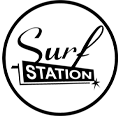This was our distance for the day, over sea rather than land
We expected big weather–wind and rain —on day four. There was a front approaching from the north, bringing rare weather to Southern California for this time of year.
We had a quick surf after camping at the beautiful beachfront Emma Wood grounds. The sun emerged and the oily smooth surf started to show signs of wind arriving. Gentle peaks and chops moved in from the Santa Barbara Channel so we prepared the kayaks. In order to miss most of the oncoming storm front we needed to make perhaps the longest leg of the trip, at least 35 miles from Emma Wood to Leo Carillo, past the slightly sketchy Point Mugu military base.
The trip was beautiful and surprisingly warm. It was stunning to watch the colors and shades of the water change as blankety clouds unfurled and then dissipated, to watch turquoisy blues fade to emerald greens and then reemerge as an ineffable amalgamation of the two. Cruising about 7 miles offshore, we surfed along small swell lines with pods of common dolphins and a variety of sea birds.
At one point an unmarked helicopter strated circling around our five crafts. It kept going for 25, 35, 45 minutes. Then another helicopter came out, took the first helicopters position encircling us and the first helicopter flew away. It definitely felt like they were trying to communicate something. Dave switched his radio to another channel and finally made contact with them–The U.S. Navy, as it turned out. We saw a bright orange boat coming quickly from the shoreline straight toward us so we quickly put on our life jackets just to assure that we were as seemingly law abiding as possible. We weren’t sure if we had inadvertently broken some law, or if they were just harassing us. The orange boat stopped abruptly and insisted that we pull sail and wait exactly where we were—not to move any further. The captain informed us that the U.S. Navy was conducting live missile testing for the next 15 minutes and that we were required to wait until the testing had completed. So we waited, watching all around for explosions or signs of some militaristic destruction, but nothing we saw.
About 20 minutes later massive gray jets flew overhead, erupting in sounds that seemed to violently rip open the sky. It was a stark contrast to the gentle lapping ocean sounds and occasionally ruffling of my sail overhead. A sound uniquely human in scope, from sky to sea. I couldn’t help to wonder how the dolphins we had just had the pleasure of sailing with were affected. So sensitive to sound with their finely tuned echolocation capabilities, were these explosive sounds hurting their ears, too? What else does the military base here, so close to so many humans and countless marine species, do to this beautiful ocean? What else does it empty into these bountiful waters? Do we as taxpayers support our military conducting such experiments into delicate marine ecosystems– potentially threatening endangered and threatened species? I couldn’t help but wonder.
We sailed onward, making good time. The wind died down for awhile, so we peddled a bit and had a snack. We were starting to think that we wouldn’t make it to shore before dark. Just as the sun was beginning to set a steady wind hit our sails, a perfect homecoming wind, sending us easily onto the beach in time to watch the sun sink below the horizon with our ground crew. To see their smiling, welcoming faces on the beach after each long day of sailing ( today took about 7 hours) is really like being welcomed home in each destination.
It’s a beautiful feeling to celebrate each evening with friends at the edge of the sea.











It’s funny to think of how much more the Mrs. and I would rather be doing this than sitting in cubeland. Any chance of this voyage happening in FL next year?